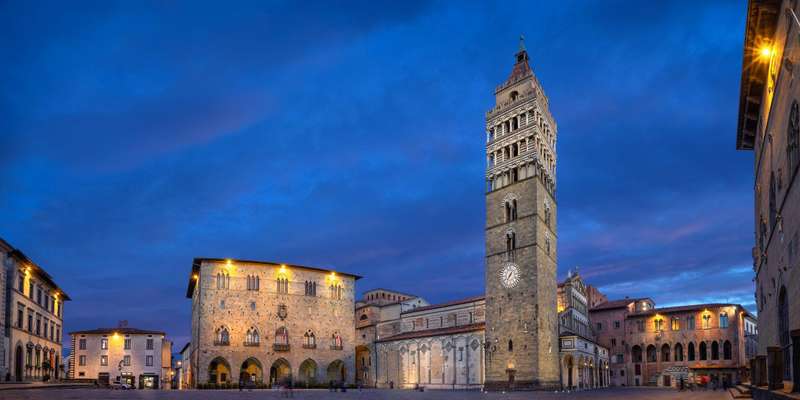- Home
- Useful Tips
- Pistoia's medieval history
Many travelers overlook Pistoia's medieval treasures, rushing through or skipping it entirely for more famous Tuscan destinations. This hidden gem, just 30 minutes from Florence, offers an authentic medieval experience without the crowds – yet 78% of visitors miss its most fascinating historical sites according to local tourism boards. The challenge lies in navigating the compact but intricate old town efficiently, where 12th-century churches hide behind unassuming facades and local artisans still practice centuries-old crafts in plain sight. Without proper guidance, you might waste precious vacation hours circling the same piazzas or, worse, leave unaware of Pistoia's extraordinary Ospedale del Ceppo with its iconic Renaissance ceramic frieze. The stress of maximizing limited time in an unfamiliar medieval city can overshadow the joy of discovery, especially when language barriers complicate accessing deeper historical insights.


Decoding Pistoia's medieval street plan – how to navigate without getting lost
Pistoia's concentric medieval layout, radiating from Piazza del Duomo, seems simple until you encounter its web of alleyways (chiassi) designed for 14th-century defense. The key is identifying the three original Roman gates – Porta Lucchese, Porta al Borgo, and Porta Carratica – which still anchor the historic center. Start at the octagonal Baptistery, your orientation point, where the four main streets divide the town into distinct medieval quarters. Watch for subtle clues like the 'via vecchia' (old road) markers on buildings that trace original pilgrim routes. Locals suggest following the 'corso' streets for major landmarks, while narrower vicoli often lead to surprising discoveries like the hidden Chiesa di Sant'Andrea with its Pulpit of St. Andrew. Morning light best illuminates directional markers carved into stone corners by medieval builders.
Pistoia's must-see medieval sites most tourists miss
Beyond the famous Cathedral of San Zeno, Pistoia safeguards lesser-known medieval marvels. The 12th-century San Giovanni Fuorcivitas church displays a rare striped marble exterior and exquisite Romanesque pulpit, often overlooked because it sits just outside the ancient walls (hence 'fuorcivitas'). The Palazzo dei Vescovi's underground archaeological walk reveals medieval foundations beneath the bishop's palace, including a perfectly preserved 11th-century pharmacy. For a truly local experience, visit the tiny Oratorio di San Desiderio where 14th-century frescoes depict Pistoia's medieval wool trade. Time your visit for Thursday mornings when the centuries-old Hospital of the Ceppo opens its surgical theater museum, showcasing medieval medical instruments. These sites require no tickets, just awareness of their limited opening hours – a detail even many guidebooks omit.
Medieval artisan workshops still operating in Pistoia today
Pistoia's living medieval heritage shines in its continuing artisan traditions. The Bottega d'Arte Masini near Piazza della Sala has produced hand-bound books using 15th-century techniques since 1980. Watch master goldsmiths at Antica Oreficeria Pacchi create filigree jewelry as their ancestors did near the old market square. For authentic medieval flavors, family-run Pistori a Pistoia bakes pan co' santi (saint's bread) following 13th-century recipes with local walnuts and raisins. These workshops often welcome visitors for brief demonstrations, especially in quieter morning hours. Locals recommend the leather atelier Il Torchio, where artisans tool designs identical to those on medieval pilgrims' satchels. Supporting these craftspeople helps preserve Pistoia's tangible connection to its past while taking home truly unique souvenirs.
Timing your visit for Pistoia's medieval festivals and events
To experience Pistoia's medieval spirit most vividly, align your visit with the Giostra dell'Orso in July, a historic jousting tournament dating to 1250 where knights in full armor compete near the cathedral. Winter visitors shouldn't miss the atmospheric Mercato nel Tempo in December, when the entire center transforms into a medieval marketplace with blacksmiths, scribes, and food stalls using ancient recipes. For quieter immersion, September's Pistoia Blues Festival often includes medieval music performances in cloisters. Locals know the best free viewpoints for these events – the loggia of Palazzo Comunale offers perfect sightlines without crowds. These living history moments make Pistoia's medieval past feel vibrantly present, especially when you've learned to read the city's architectural clues from earlier explorations.
